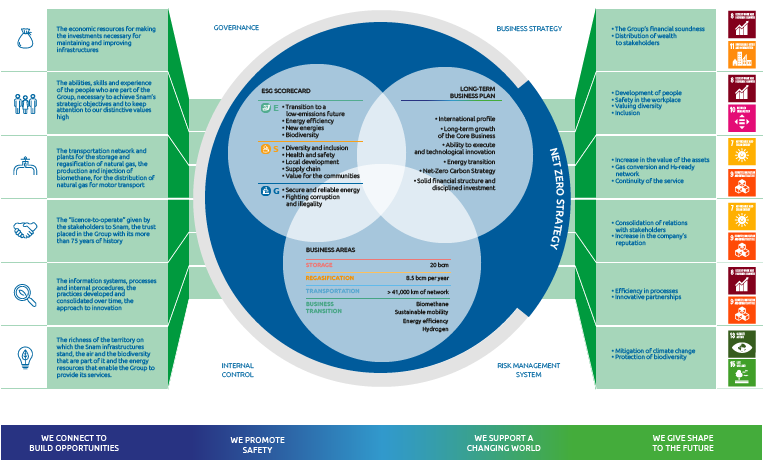Sustainable value creation: the Snam business model
Snam’s business model is based on sustainable growth, transparency, the enhancement of talent and diversity, and the protection and social development of local areas, also through the work of Fondazione Snam.
The Group bases its business model on its values, integrating new commitments relative to the energy transition with its traditional core business. This model pursues sustainable success through the creation of long-term value to benefit shareholders, while simultaneously considering the interests of other relevant stakeholders. The business plan and ESG coexist and are interconnected, with the goal of providing a concrete contribution to the achievement of the United Nations Sustainable Development Goals.
The repositioning of the company in recent years and the projects called for the in the new plan create the conditions for the Group to take advantage of the opportunities provided by the energy transition, in part thanks to the skills acquired by Snam personnel and the increasing digitalisation of processes.
Description of capital
Financial capital
The economic resources for making the investments necessary for maintaining and improving infrastructures.
Human capital
The abilities, skills and experience of the people who are part of the Group, necessary to achieve Snam’s strategic objectives and to keep attention to our distinctive values high.
Infrastructural capital
The transportation network and plants for the storage and regasification of natural gas, the production and injection of biomethane, for the distribution of natural gas for motor transport.
Relational capital
The “licence-to-operate” given by the stakeholders to Snam, the trust placed in the Group with its more than 75 years of history.
Intellectual capital
The information systems, processes and internal procedures, the practices developed and consolidated over time, the approach to innovation.
Natural capital
The richness of the territory on which the Snam infrastructures stand, the air and the biodiversity that are part of it and the energy resources that enable the Group to provide its services.
The Snam business model
The creation of value
Financial capital
- The Group’s financial soundness
- Distribution of wealth to stakeholders


Human capital
- Development of people
- Safety in the workplace
- Valuing diversity
- Inclusion


Infrastructural capital
- Increase in the value of the assets
- Gas conversion and H₂-ready network
- Continuity of the service


Relational capital
- Consolidation of relations with stakeholders
- Increase in the company’s reputation


Intellectual capital
- Efficiency in processes
- Innovative partnerships


Natural capital
- Mitigation of climate change
- Protection of biodiversity


